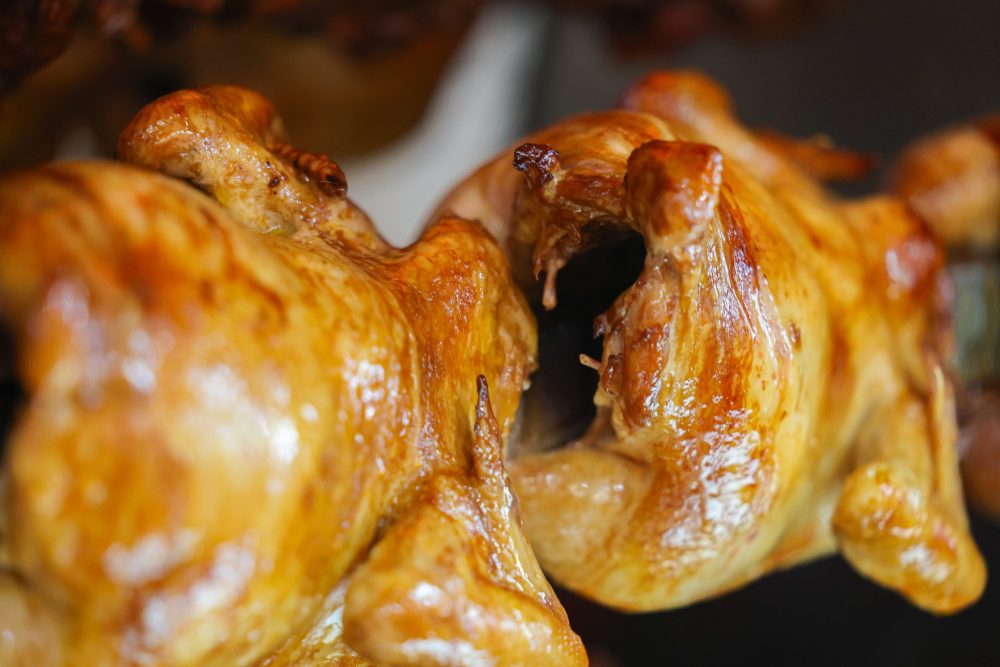Few dishes can compete with the universal appeal of rotisserie chicken. Golden-brown, tender, and bursting with flavor, it’s a versatile meal that’s perfect for everything from weeknight dinners to special occasions. But what makes rotisserie chicken so special, and can you recreate the magic at home? Absolutely! Here’s a closer look at the process, why it’s so beloved, and how to make your own rotisserie-style chicken without the commercial rotisserie.
The Art of Rotisserie Chicken
At its core, rotisserie chicken is all about even cooking and flavor infusion. Traditionally, it’s made by skewering a whole chicken on a spit and slowly rotating it over a heat source. This process achieves two key results:
- Crispy Skin: The continuous rotation ensures the chicken bastes itself in its own juices while the heat crisps up the skin to golden perfection.
- Juicy Meat: Slow, even cooking prevents the meat from drying out, keeping it tender and moist.
The magic doesn’t stop there. Rotisserie chicken is often seasoned with a blend of herbs, spices, and marinades, giving it layers of flavor that seep into every bite.
Recreating Rotisserie Chicken at Home
While you might not have a commercial rotisserie oven, you can still achieve the same tender, flavorful results with a few simple tools and techniques. Here’s how:
What You’ll Need
- A whole chicken (3-4 lbs)
- Your favorite seasoning blend (recipe below)
- A roasting pan with a rack, or a vertical chicken roaster
- Optional: A grill with a rotisserie attachment for an authentic experience
Step 1: Seasoning the Chicken
The secret to great rotisserie chicken lies in the seasoning. You can use a store-bought rub or make your own. Here’s a simple, flavorful blend:
Homemade Rotisserie Seasoning:
- 2 teaspoons paprika
- 1 teaspoon garlic powder
- 1 teaspoon onion powder
- 1 teaspoon dried thyme
- 1 teaspoon dried rosemary
- 1/2 teaspoon black pepper
- 1/2 teaspoon cayenne pepper (optional for heat)
- 1 teaspoon salt
- 2 tablespoons olive oil or melted butter
Instructions:
- Mix the spices with olive oil or butter to form a paste.
- Pat the chicken dry with paper towels to ensure crispy skin.
- Rub the seasoning paste generously over the entire chicken, including under the skin and inside the cavity.
Step 2: Prepare for Cooking
Option 1: Oven Method
- Preheat your oven to 375°F (190°C).
- Place the chicken on a roasting rack set in a pan. This allows air to circulate and helps mimic the even cooking of a rotisserie.
- Roast the chicken for about 1.5 hours, or until the internal temperature reaches 165°F in the thickest part of the breast and 175°F in the thigh.
- Baste the chicken with its drippings halfway through cooking for extra flavor.
Option 2: Grill Method
- If your grill has a rotisserie attachment, skewer the chicken onto the spit and secure tightly.
- Preheat the grill to medium heat and place a drip pan under the chicken to catch juices.
- Rotate the chicken on the spit for 1-1.5 hours, or until it reaches the proper internal temperature.
- No rotisserie? Place the chicken over indirect heat on the grill, turning occasionally for even cooking.
Step 3: Rest and Serve
Once the chicken is cooked, let it rest for 10-15 minutes before carving. This allows the juices to redistribute, ensuring every bite is moist and flavorful. Pair your rotisserie-style chicken with classic sides like roasted vegetables, mashed potatoes, or a fresh salad.
Why Make Rotisserie Chicken at Home?
- Customizable Flavors: Adjust the seasoning to suit your taste or experiment with marinades for a new twist.
- Healthier Ingredients: Control the quality of your chicken and avoid unnecessary additives often found in store-bought versions.
- Budget-Friendly: A homemade rotisserie chicken is often more affordable than pre-cooked options, with the added benefit of leftovers for soups, salads, or sandwiches.
Tips for Success
- Truss the Chicken: Tie the legs and wings close to the body with kitchen twine. This helps the chicken cook evenly and prevents burning.
- Use a Meat Thermometer: Ensure the chicken is cooked to the correct internal temperature for food safety and optimal juiciness.
- Don’t Skip the Resting Step: It might be tempting to carve right away, but patience pays off in the form of juicy meat.
Conclusion
Rotisserie chicken is more than a meal—it’s a celebration of rich, comforting flavors. By following these steps, you can bring the experience of perfectly cooked rotisserie chicken into your own kitchen. Whether you’re savoring it fresh out of the oven or repurposing leftovers, this versatile dish is sure to become a staple in your cooking repertoire. So roll up your sleeves and get ready to enjoy the crispy, juicy goodness of homemade rotisserie chicken!


